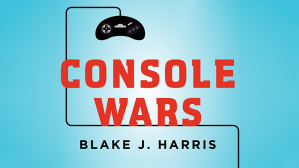Blog Archives
Console Wars: Book Review
 I finally finished reading through Blake J. Harris’ Console Wars, (one week reading time) and I can confidently say that, outside of fantasy and poetry, it is the most enjoyable book I have ever read. Even during the week and with my duties (correcting papers, preparing lessons, etc) I often found myself sneaking time in to be able to follow the exploits of SEGA of America and its team of executives. As I mentioned in my First Impressions post, the book focuses on the only true console war that the video game industry has ever experienced – the 16 bit console war. The book chronicles the exploits of Tom Kalinske and his steam at SEGA of America as they grow the small company from one with a hold on a meager 5% of the video game market share to a gargantuan powerhouse that at its highest point dominated over 60% of the 16-bit market.
I finally finished reading through Blake J. Harris’ Console Wars, (one week reading time) and I can confidently say that, outside of fantasy and poetry, it is the most enjoyable book I have ever read. Even during the week and with my duties (correcting papers, preparing lessons, etc) I often found myself sneaking time in to be able to follow the exploits of SEGA of America and its team of executives. As I mentioned in my First Impressions post, the book focuses on the only true console war that the video game industry has ever experienced – the 16 bit console war. The book chronicles the exploits of Tom Kalinske and his steam at SEGA of America as they grow the small company from one with a hold on a meager 5% of the video game market share to a gargantuan powerhouse that at its highest point dominated over 60% of the 16-bit market.
The book, written in accessible prose, is full of interesting (if remixed) conversations between Kalinske and his lieutenants at SEGA of America. Some of the most memorable figures in the story include Al Nilsen (the likable mastermind who marketed the Genesis and its 2 cool mascot), Race (a video game veteran who worked at Atari, Nintendo, SEGA, and Sony, and whose comments on Japanese culture made him come across as one of the least likable figures on Kalinske’s team), EBVB (Ellen Beth Van Buskirk Knapp, a brilliant executive whose efforts helped build the image of the Genesis as the “cool” gaming system), and Shinobu Toyoda (the liaison between SEGA of America and SEGA of Japan).
Although the book does go into historical events that changed the face of the gaming landscape and the industry as a whole, such as its exposition of the lawsuits between Universal and Nintendo over Donkey Kong and the clash between EA, who successfully reverse-engineered the Genesis, and SEGA, its focus is not to document historical events as much as it is to chronicle the story of a company and its CEO, and it does so brilliantly.
My favorite thing about the book is how it sheds light on the events and corporate philosophies and decisions going on behind the curtain – events that help shed on the disastrous turn of events that happened for SEGA during the end of its 16-bit days and that help explain, to some extent, the current condition of the Wii U.
*Spoilers ahead*









































